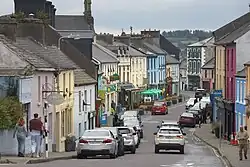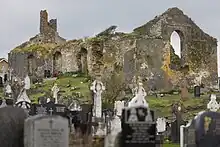Schull
Schull or Skull[2] (/ˈskʌl/ SKUL; Irish: An Scoil or Scoil Mhuire, meaning "Mary's School")[2] is a town in County Cork, Ireland.
Skull
Irish: Scoil Mhuire / an Scoil Schull | |
|---|---|
Town | |
 Schull's main street | |
 Skull Location in Ireland | |
| Coordinates: 51°31′36″N 9°32′53″W | |
| Country | Ireland |
| Province | Munster |
| County | County Cork |
| Population | 700 |
| Time zone | UTC+0 (WET) |
| • Summer (DST) | UTC+1 (IST (WEST)) |
| Irish Grid Reference | V924317 |
| Website | www |



Located on the southwest coast of Ireland in the municipal district of West Cork,[3] the town is dominated by Mount Gabriel (407 m). It has a sheltered harbour, used for recreational boating. The area, on the peninsula leading to Mizen Head, is a tourist destination, and there are numerous holiday homes along the adjoining coast. Schull had a population of 700 in 2016.[1] The town's secondary school, Schull Community College, houses one of the only planetariums in Ireland,[4] along with a sailing school. Each year Schull harbour hosts the Fastnet International Schools Regatta.
Name
The first recorded place name for this area is "scol", from a Decretal Letter of Pope Innocent III in 1199 to the bishop of Cork confirming the rights of the bishop of Cork. Both Skull and Skul are used in the Down Survey of 1656–58.[5] Skull is also used in the Grand Jury Map surveyed in the 1790s and published 1811.
The Placenames (County Cork) Order of 2012 lists "An Scoil" as the Irish name for the village, in which "Scoil" is translated from "school".[2] This is attributed by some to a school which was ostensibly located in the area.[6][7][8]
However, others question this derivation, and Gary Dempsey's thesis ("Whispered in the Landscape/Written on the Street, A Study of Placename Policy and Conflict in Ireland from 1946 to 2010") suggests that the "Scoil Mhuire" form dates to 1893 when the parish priest of Schull at the time, Very Rev. John O'Connor (P.P. Schull 1888–1911), who "fancied himself as a historian, misread a Latin sentence as referring to a 'College of St. Mary' in Skull; in fact, the text referred to a collegiate church in Waterford but the PP had set the ball rolling".
History
Evidence of ancient settlement in the area includes a number of ringfort, rock art and fulacht fiadh sites in the townlands of Skull, Caherlusky, Cooradarrigan and Gubbeen.[9] The megalithic Altar Wedge Tomb lies to the west of the town. Settlement in Schull itself dates to at least the 12th century,[10]
In the early 17th century, the townland of Leamcon was a pirate stronghold, at a time when pirates traded in nearby Baltimore and Whiddy Island.[11] Between the 17th and 18th century, the center of the town may have shifted somewhat, from the now ruined medieval church, towards the modern main road. The medieval church itself was largely rebuilt in 18th century, but later fell into ruin when the Holy Trinity church, closer to today's town center, was built.[10]
By the late 19th century, businesses in Schull (including banks, pubs and an inn) served the surrounding area.[10] In 1889, a stick barometer was gifted to the people of Schull by representatives of the London Meteorological Office who gave a series of lectures on barometers to fishermen and sailors.[10] The barometer is now on display next to the local An Post office.
Transport
Schull once had its own railway station, which was the western terminus of the Schull and Skibbereen Railway, a steam-operated narrow gauge railway. Schull railway station opened on 6 September 1886, closed for passenger and goods traffic on 27 January 1947, and finally closed altogether on 1 June 1953.
The main bus route is Bus Éireann's number 237 to/from Cork City, though only some services reach Schull.[12][13] Also, on occasional days there are buses to/from other towns/villages in the local area.[14]
There is a ferry service between Schull and Cape Clear Island.[13][15]
In literature
The book Silver River (2007)[16][17] by Daisy Goodwin includes a section on the efforts of her 3x great-grandfather, the Rector of Skull, to help the populace during the Great Famine.
Notable people
- Fionn Ferreira, scientist and winner of the 2019 Google Science Fair, attended Schull Community College.[18]
- Timothy O'Hea, recipient of the Victoria Cross was born in the area[19][20]
- Ralph Allan Sampson, astronomer, born here
- John Sampson, linguist and Romani scholar, born here
- Sophie Toscan du Plantier, French television producer murdered on the night of 23 December 1996
- Robert Traill (1793–1847), the local rector, who was notable for his efforts to alleviate suffering during the Great Irish Famine.[21]
- Colin Vearncombe, English singer-songwriter, known professionally as Black, lived in Schull[22]
References
- "Census 2016 Sapmap Area - Settlements - Schull". CSO. 2016. Archived from the original on 18 August 2018. Retrieved 18 August 2018.
- "An Scoil / Skull". logainm.ie. Placenames Database of Ireland. Archived from the original on 12 June 2012. Retrieved 27 June 2020.
- "Cork Local Area Plans - West Cork Municipal District". corklocalareaplans.com. Cork County Council. Archived from the original on 11 July 2021. Retrieved 13 September 2021.
- "Welcome To Schull Planetarium". westcorkweb.ie. Archived from the original on 7 August 2020. Retrieved 27 June 2020.
- William Petty, ed. (1656). Down Survey Maps - Barony of Carbury. Archived from the original on 22 April 2021. Retrieved 21 September 2017 – via Library of Trinity College, Dublin.
- Kieran McCarthy; Daniel Breen (2013). West Cork Through Time. Amberley Publishing. ISBN 978-1-4456-2079-4.
The name is derived from Scoil Mhuire, or Our Lady's School
- Con O'Leary (1936). Con O'Leary. p. 173.
Schull, named from Scoil Mhuire, the School of Mary, in the sixth century
- Joseph A. King (1994). Ireland to North America: Emigrants from West Cork. K&K Publications. ISBN 978-0-88835-044-2.
[..] a local school from which some think the village of Schull derived its name.
- Archaeological Inventory of County Cork. Volume 5. Dublin: Government Stationery Office. 2009. ISBN 978-1-4064-2449-2.
- Heritage Towns And Villages of County Cork. Cork County Council, The Heritage Council. 2022. p. 351. ISBN 978-1-911677-09-3.
- Senior, Clive M. (1976). A Nation of Pirates. Newton Abbot: David & Charles. pp. 41, 54–57, 68. ISBN 0 7153 7264 5.
- "Bus Éireann - Timetable search - Route 237". Archived from the original on 17 September 2021. Retrieved 17 September 2021.
- "Birdwatch Ireland - Cape Clear Bird Observatory - Other information". birdwatchireland.ie. Archived from the original on 17 September 2021. Retrieved 17 September 2021.
- "Schull - Locallink Cork". Retrieved 12 May 2022.
- "Cape Clear Ferries - Schull Ferry". Archived from the original on 1 March 2021. Retrieved 17 September 2021.
- Goodwin, Daisy (2007). Silver River. Fourth Estate. ISBN 978-0-00-655153-9.
- "Review: 'Silver River' by Daisy Goodwin". theguardian.com. The Guardian. 17 November 2007. Archived from the original on 5 October 2016. Retrieved 13 December 2016.
- "Irish teenager wins Google science award for microplastics project". irishtimes.com. Irish Times. Archived from the original on 27 November 2019. Retrieved 27 November 2019.
- "Timothy O'Hea VC". vconline.org.uk. Retrieved 12 May 2022.
- Best, Brian (2021). The Victoria Cross in 100 Objects. p. 63. ISBN 978-1-5267-3079-4.
O'Hea was born at Schull, County Cork on 11 June 1843. Like many of his countrymen, poverty forced him to join the British Army
- Saunders, Tristram Fane. "Victoria: what is the truth about the Irish Famine, and who was Robert Traill?". telegraph.co.uk. Daily Telegraph. Archived from the original on 2 October 2017. Retrieved 2 October 2017.
- "Singer-songwriter 'Black' dies following car crash in Cork". irishtimes.com. Irish Times. 26 January 2016. Archived from the original on 26 October 2020. Retrieved 27 June 2020.
External links
 Schull travel guide from Wikivoyage
Schull travel guide from Wikivoyage- Schull.ie Website
